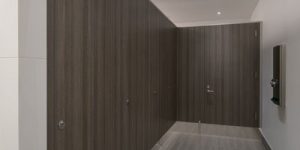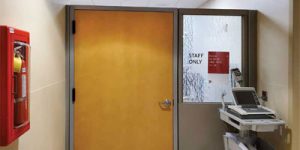The acoustics are the heart and soul of the church. When the architect gets it right, they can enhance the emotional, intellectual, and spiritual impact of a church sermon or musical performance, helping to make church services a truly unforgettable experience for worshippers.
+ Read More
|
With a greater understanding of indoor environmental quality, acoustic ceiling material choices, and relevant product certifications, specifiers can have a positive impact on buildings’ indoor air quality, lighting, safety, acoustic comfort, and on people’s health and well-being.
+ Read More
|
There are several key considerations that door hardware must comply with to meet Americans with Disabilities Act (ADA) requirements, including the approach to the door, the opening clearance, thresholds, surfaces, operating hardware, closing speed, opening force, and exit door signage.
+ Read More
|
National Cowboy & Western Heritage Museum’s Annie Oakley Society Event Center in Oklahoma City incorporates a linear metal ceiling system with a walnut woodgrain finish that visually connects the event center’s interior with the museum’s outdoor exhibits and landscape.
+ Read More
|
New transgender access legislation has transformed privacy from a trend to more of a permanent expectation across a range of building types, from Class A offices to high schools. There are five key categories of restroom privacy solutions, spanning from traditional partitions to single-user individual toilet rooms.
+ Read More
|
To achieve ‘better acoustics’ and fulfill the objective of designing with the occupant in mind, one must turn their attention to the sound present in the space and look at it through the lens of both architectural acoustics and psychoacoustics.
+ Read More
|
Track rail glass products were used at the Kentucky Convention Center (Louisville) to line the grand staircase, large stair landing, ramps, and overlooks, allowing natural light from the updated glass façade to flow through the multiple levels of the facility.
+ Read More
|
It would be a mistake to assume closer hinges will replace overhead closers in all locations. However, closer hinges have proven their utility for many entrance conditions, and may even prove to be the preferred solution for many ordinary doorways.
+ Read More
|
The IBC is recognized as the model building code for commercial construction, which is then adopted by state and local jurisdictions. Through NFPA 285, increasing use of energy efficient continuous insulation (ci) and innovative wall assemblies places a greater emphasis on fire performance of exterior walls.
+ Read More
|
The OMNI Louisville Hotel and Residence, Louisville, Kentucky, utilizes architectural railings to complement its modern, minimalist design.
+ Read More
|
|
|














